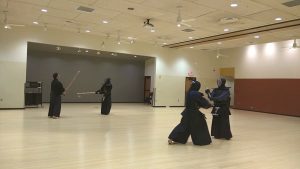As the old saying in kendo goes, “1. eyes, 2. footwork, 3. courage, and 4. strength” (一眼 二足 三膽 四力; ichi-gan ni-soku san-tan shi-riki), seeing is considered to be the most important. The act of seeing is divided into two aspects (観見の目) one that of sensing or perceiving [as mentally] (観; kan) the whole of your opponent, and another is that of simply observing [as physically] (見; ken).
1) Observing eyes
There is a saying, “eyes are the mirror of the soul.” It’s possible to read a person’s heart through his eyes. If the heart is in disorder the eyes are murky, and if the heart is clean the eyes are clear. There are some who look at the target (men, kote, dou, or tsuki) before making a cut, and that is akin to relaying to your opponent where you are going to be cutting. So, if you want to read the other person’s intention you have to practice to observe your opponent’s eyes and read the heart.
2) Seeing eyes
You can sense the movement of your opponent’s whole body through his eyes. This is because the human field of vision sees best 30 degrees from the line that connects the upper part of the ears to the eyes. There are some who look at opponent’s tsuba or hand to avoid any attack, or focuses on the feet to see the movement, but you can’t track the movement of shinai with your eyes, and you can’t see the whole if you focus on one point.
Therefore, you should see as if you’re seeing a far-away mountain, and also see opponent’s eyes to comprehend your opponent’s whole (heart and mind).
* This is a translation from Jissen Kendo by Edo Kokichi kyoshi.
恵土孝吉. スポーツQ&Aシリーズ 実戦剣道. 東京都: 大修館書店, 1985. Print. Q 7.
